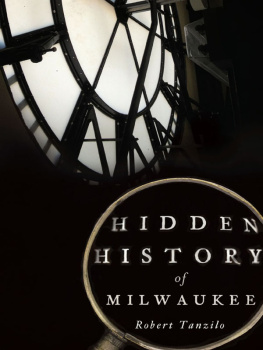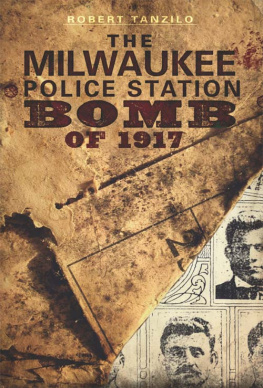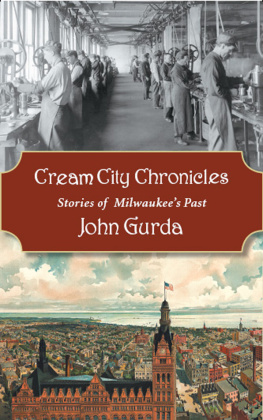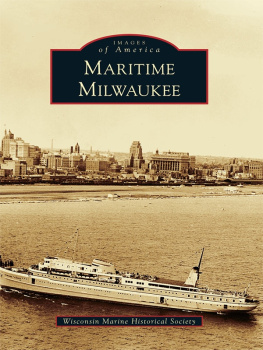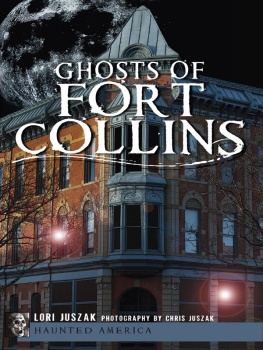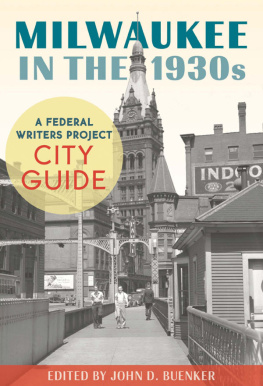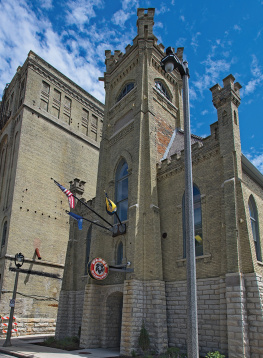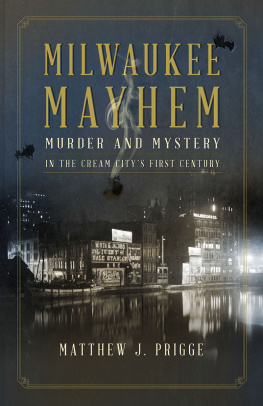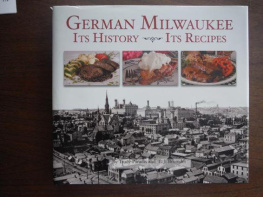

Published by The History Press
Charleston, SC 29403
www.historypress.net
Copyright 2014 by Robert Tanzilo
All rights reserved
Much of this work previously appeared, sometimes in different forms, at OnMilwaukee.com and is included here with kind permission. All images are courtesy of the author unless otherwise noted.
First published 2014
e-book edition 2014
ISBN 978.1.62584.989.2
Library of Congress Cataloging-in-Publication Data
Tanzilo, Robert, 1966
Hidden history of Milwaukee / Robert Tanzilo.
pages cm
Includes index.
print edition ISBN 978-1-62619-451-9
1. Milwaukee (Wis.)--History. I. Title.
F589.M657.T36 2014
977.595--dc23
2014012332
Notice: The information in this book is true and complete to the best of our knowledge. It is offered without guarantee on the part of the author or The History Press. The author and The History Press disclaim all liability in connection with the use of this book.
All rights reserved. No part of this book may be reproduced or transmitted in any form whatsoever without prior written permission from the publisher except in the case of brief quotations embodied in critical articles and reviews.
For Arthur Holtz, because whenever Ive been up high, gazing out over this city, I wish I could tell him about it afterward.
Contents
Acknowledgements
Above all, as always, I owe a debt of gratitude to my familyKathy, Luca and Valentinafor making time for me to get this done.
A big thank-you is also in order for Andy Tarnoff, who as publisher at OnMilwaukee.com, has always allowed me to follow my muse and has offered kind permission to reprint work here that first appeared at OnMilwaukee.com. Thanks also to my OnMilwaukee.comrade Molly Snyder for her valiant duty as my occasional photographer on the missions collected here. (Andys done that duty, too.)
I couldnt have done these pieces without the assistance of my tour guides, most of whom are named in their respective chapters, and without the help of the folks at Historic Milwaukee Inc., especially Amy Grau, who, as the coordinator for the annual Doors Open Milwaukee, has a Rolodex of names and numbers that quite literally opens doors throughout this towna massive shout-out to them all. A kind nod of gratitude to Brooke VandeBerg, Mary Milinkovic and the staff at Milwaukee Public Library for graciously granting permission to use photographs from their collection. Thanks also to Robert Kennedy at WE Energies and to William Coughlin at AT&T.
Thanks, finally, to the entire team at The History Press, with whom its always a pleasure to work.
Introduction
History is all around us. Sure, its a clich, but its true. In Milwaukee, as in all places, history is not only in the buildings we see every day but also in the absence of the buildings they replaced or once stood beside. Its in the names of streets, and its hidden in the bones of the city. Its in us. It is us. We are writing the history of the future.
When I started to write these pieces for OnMilwaukee.com, I ran them under the banner urban spelunking, not because I was breaking into forbidden places and not because I was exploring actual cavesthough I did the latter (but never the former) a couple timesbut because I was looking for history in the everyday places of the city: in the landmarks we celebrate, in the familiar places we take for granted and in some typically off-limits places we all are curious about seeing. It felt a bit like spelunking in broad daylight.
I hope that opening some of these doors and shining a light on some of these places helps us get a better feel for the history of Milwaukee and for the flavor of this town. At the very least, I hope the journey is as fun for you as its been for me.
Where Milwaukee Was Born
Digging Down into Water and Wisconsin
Dont feel bad if youve never seen the plaque affixed to 100 East Wisconsin Avenue, explaining the historical relevance of the northwest corner of Water Street and Wisconsin. Its on the lower level of the building, facing the RiverWalk. Ive passed it countless times and never noticed. Its greenish-brown patina makes it easy to miss.
But one day, it caught my eye. I photographed it and then spent some time digging to fill in a bit more of the story of this corner that is the birthplace of modern Milwaukee.
Our story begins with Antoine Franois LeClaire, who was born in 1768 in St. Antoine De La Rivire du Loupe, Louiseville, Quebec. By 1795, when his son Franois was born, LeClaire was in St. Joseph, Michigan, straight across the lake from Chicago.
But by the time his third childdaughter Josettearrived in December 1799, LeClaire was in Milwaukee. LeClaires wife, Marie Savagesse, was a member of the Potawatomi tribe, which presumably explains her unusualand to modern ears, politically incorrectsurname.
In 1800, LeClaire built a log cabin on the Milwaukee River, on the site of the current 100 East Wisconsin office tower. Not only was that modest cabin the first house built on the east side of Milwaukee, but it was also, presumably, the first commercial building.
Though there were certainly indigenous people living in the areaincluding residents of a Potawatomi settlement directly across the river, according to an April 1920 article by Publius V. Lawson published in the Wisconsin Archeologistbecause LeClaire selected the site for his cabin, it seems unlikely any lived on the piece of land in question.
Some have claimed that LeClaires son Antoine (Jr.) followed in his fathers footsteps, opening his own trading post to make deals with the local Native Americans, at the precocious age of twelve.
Soon, the LeClaires had company. Another Qubcois, Solomon Juneau, had arrived in Milwaukee in 1818 as a representative of the American Fur Co. Some accounts say that Juneau built a cabin next to LeClaires at this time, though other versions are contradictory.
In 1820, Juneau married Josette Vieau, whose father, Jacques, built a cabin in 1795 on the bluff above the Menomonee Valley in what is now Mitchell Park, where the couple lived for a while. There is another plaque that marks that site. After a few years traveling between posts in Wisconsin, the Juneaus returned to Milwaukee.
In 1825, Juneau erected a cabin, stockade and store, just east of the LeClaire place, facing what is now Water Street. Ten years later, he added a large warehouse.
LeClaire left Milwaukee and married twice more, in 1819in Portage des Sioux, Missouriand in 1821, and some of his children became well-known businessmen and philanthropists in the upper Midwest.
But Juneau stayed later in Milwaukee and left a more indelible mark, establishing his Juneautown east of the Milwaukee River. He merged it with Byron Kilbourns Kilbourntown on the opposite shore and George Walkers Walkers Point in 1846 to create the city of Milwaukee, and he served as the new citys first mayor.
Nine years earlier, Juneau had provided the cash for editor John ORourke to start a newspaper called the Milwaukee Sentinel.
In 1848, after serving a two-year term as mayor, Juneau decamped to the town of Theresa, which he had founded in Dodge County fifteen years previous and where you can still see the home he built there.
In 1838, future governor Harrison Ludington arrived in Milwaukee from Dutchess County, New York, and became partners with his uncle Lewis Ludington in a general merchandise business that they ran out of Juneaus warehouse. In the late 30s, McDonald and Mallaby ran a corner store on the site, perhaps in one of the buildings Juneau built.
Next page
